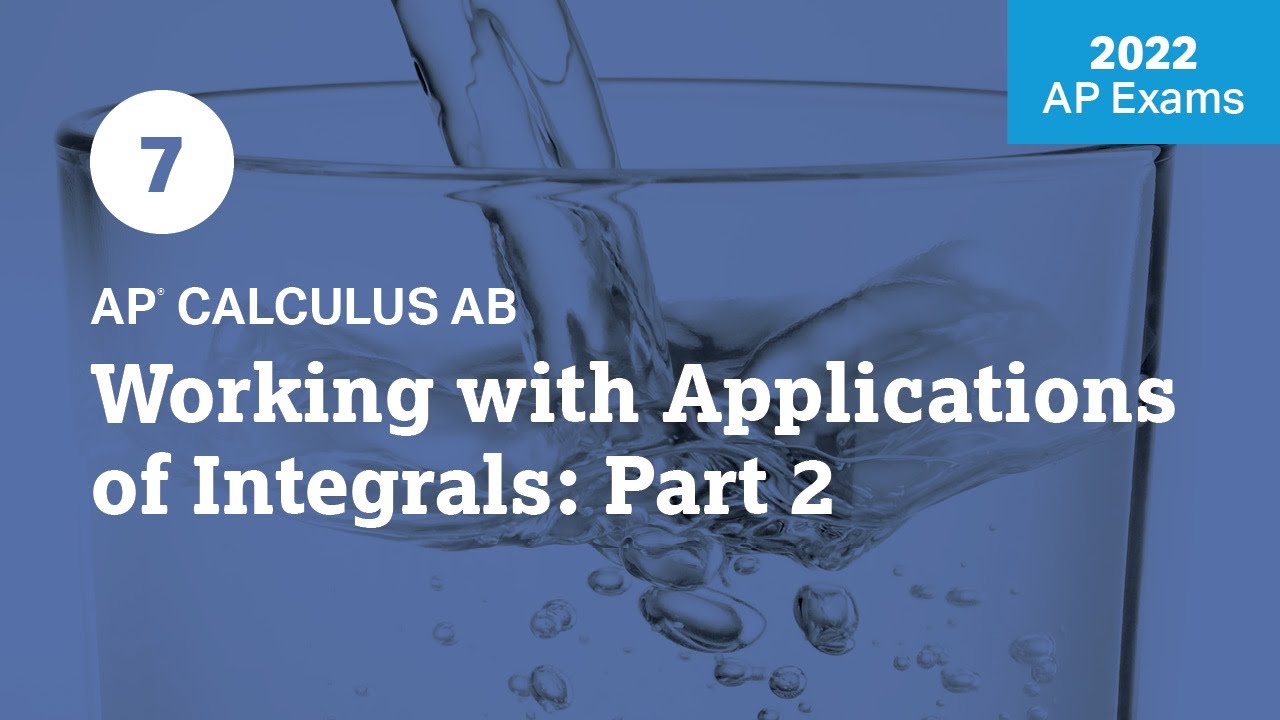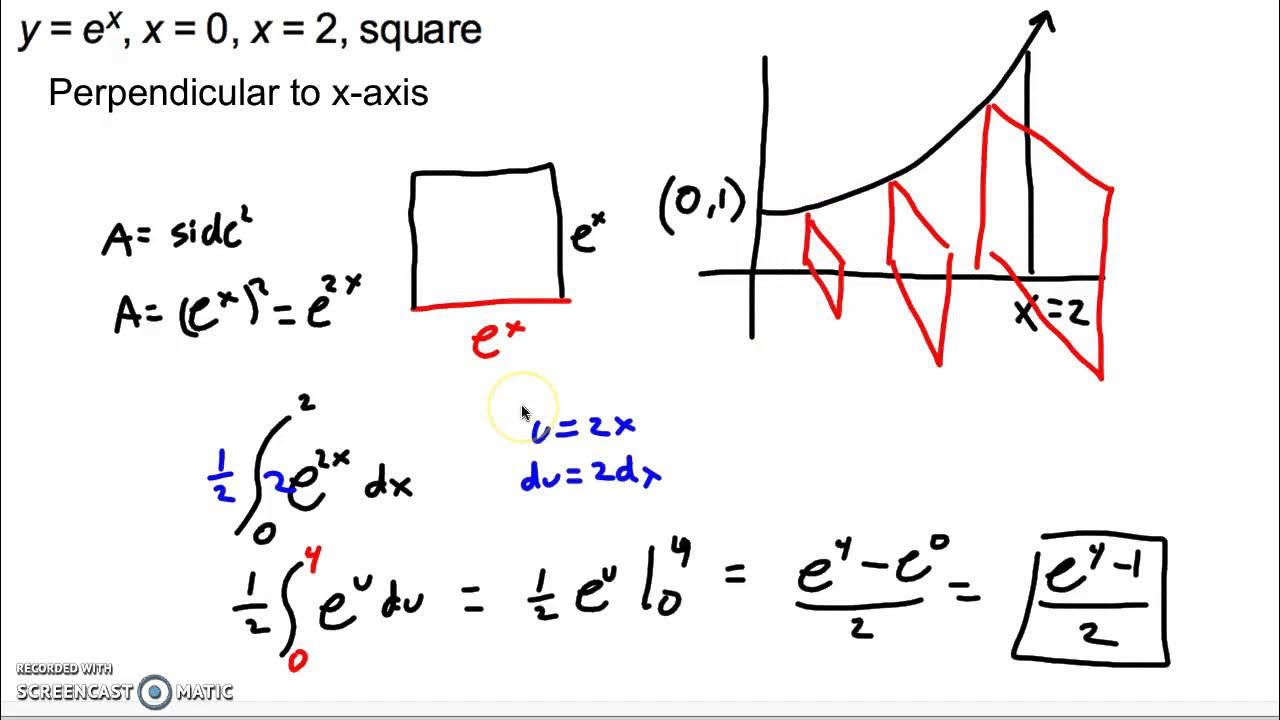Applications of Integrals Review (All of AP Calculus Unit 8)
TLDRThis video script covers the applications of integration in AP Calculus, focusing on topics such as average values, position, velocity, and acceleration using integrals, accumulation functions, and area between curves. It also delves into volumes with cross sections and volumes of revolution, including washers and complex shapes revolving around different axes. The script emphasizes the importance of understanding the fundamental theorem of calculus and its rearrangements for solving various problems, and provides a comprehensive review of integral calculus concepts, complete with examples and problem-solving strategies.
Takeaways
- 📚 The video covers applications of integration, specifically focusing on average values, position, velocity, acceleration, and volumes with cross sections and integrals.
- 🌟 Average value is calculated as the integral from 'a' to 'b' of 'f(x)' dx divided by 'b-a', and is often typed on the AP exam as 1/(b-a) times the integral from 'a' to 'b' of 'f(x)'.
- 📈 For problems involving average velocity or temperature, the average value of the velocity function should be used, represented as (1/(b-a)) times the integral from 'a' to 'b' of 'v(t)' dt.
- 🚀 Displacement and distance are key concepts, with displacement being the integral of velocity and distance being the integral of the absolute value of velocity.
- 📊 To find the total distance traveled by a particle, integrate the absolute value of velocity, being mindful of the sign and zeros of the velocity on the interval.
- 📂 The fundamental theorem of calculus can be rearranged to solve for 'f(b)' or 'f(a)', which is integral in calculating the amount of fluid in a tank or the position from velocity.
- 📝 Area between curves is found by integrating from 'a' to 'b' of the top curve minus the bottom curve, with respect to either 'x' or 'y' depending on the orientation of the curves.
- 🌐 For volumes with known cross sections, the volume is calculated by integrating the area of the cross section from 'a' to 'b'.
- 🔄 Volumes of revolution are calculated using the formula pi times the integral from 'a' to 'b' of r^2 dx or dy, depending on the axis of rotation.
- 🔧 When dealing with volumes of revolution that involve washers, the volume is found by subtracting the smaller volume from the larger volume, using pi times the integral from 'a' to 'b' of (R^2 - r^2) dx or dy.
- 📏 Arc length of a function is given by the integral from 'a' to 'b' of the square root of (1 + (f'(x))^2), where f'(x) is the derivative of the function.
Q & A
What is the average value of a function in the context of AP Calculus?
-The average value of a function is the integral from a to b of the function f(x) divided by the interval length (b-a). It is often written as (1/(b-a)) * ∫ from a to b of f(x) dx.
How is the average value of a function represented on the AP Exam?
-On the AP Exam, the average value is typically represented as 1/(b-a) times the integral from a to b of f(x) dx, which is more space-efficient.
What is the significance of the integral in calculating average values?
-The integral represents the accumulation of the function's values over the interval, which when divided by the interval length, gives the average value.
How can one remember the formula for average value?
-A mnemonic is to think of the integral over the interval from a to b, which is b-a, thus the formula is the integral from a to b of f(x) dx divided by (b-a).
What is the relationship between position, velocity, and acceleration when using integrals?
-Displacement, which is the change in position, can be found by integrating velocity. The fundamental theorem of calculus states that ∫ from a to b of f'(x) dx = f(b) - f(a), which can be rearranged to solve for f(b), representing the position at time b based on the velocity function.
How is distance different from displacement when calculating the total distance traveled by a particle?
-Distance is the total length of the path traveled by the particle and is calculated by integrating the absolute value of the velocity function. Displacement, on the other hand, is the straight-line distance from the starting point to the final position and does not involve the absolute value.
What is the fundamental theorem of calculus and how is it rearranged to solve for different variables?
-The fundamental theorem of calculus states that ∫ from a to b of f'(x) dx = f(b) - f(a). It can be rearranged to solve for f(b) as f(b) = f(a) + ∫ from a to b of f'(x) dx, and to solve for f(a) as f(a) = f(b) - ∫ from a to b of f'(x) dx.
How is the accumulation of fluid in a tank calculated using integrals?
-The accumulation of fluid in a tank is calculated by integrating the rate of change of the fluid (r(t)) from the starting time to the final time. The total amount of fluid is the initial amount plus the integral from the start time to the final time of r(t) dt.
What is the concept of area between curves and how is it calculated?
-The area between curves is the region enclosed by the graphs of two functions from a to b. It is calculated by integrating the top function minus the bottom function from a to b, which gives the signed difference in area between the two curves over the interval.
How do you handle multiple intersections when calculating the area between curves?
-When curves intersect more than once, you calculate the area for each enclosed region separately, ensuring to correctly identify the top and bottom functions for each interval. The total area is the sum of the areas of all regions.
What is the general formula for calculating the volume of a solid of revolution?
-The general formula for the volume of a solid of revolution is π times the integral from a to b of the cross-sectional area function (A(x) or A(y)) times the differential (dx or dy), depending on the axis of rotation.
Outlines
📘 Introduction to Applications of Integration
This paragraph introduces the topic of applications of integration in AP Calculus. It outlines the areas covered in Unit 8 of AP Calculus, emphasizing the importance of understanding average values, which are integral to the AP exam and BC exam. The speaker also provides a general idea of where this topic fits within college calculus courses and offers a brief explanation of average value in terms of integrals.
📊 Average Value and Exam Questions
The speaker delves into the concept of average value, explaining its mathematical representation and how it is typically presented in the AP exam. The paragraph includes examples of exam questions that involve calculating average values, such as temperature in a tub and velocity of a particle. The speaker emphasizes common mistakes students make, like forgetting the division by the interval length, and provides strategies for tackling these problems.
📐 Position, Velocity, and Acceleration with Integrals
This section discusses how to connect position, velocity, and acceleration using integrals. The speaker explains the relationship between displacement and velocity integrals, and the difference between distance and displacement. The paragraph includes examples of exam questions related to these concepts, highlighting the importance of understanding the fundamental theorem of calculus in these contexts.
📈 Accumulation Functions and Definite Integrals
The speaker introduces accumulation functions and how they relate to definite integrals. The paragraph focuses on rearranging the fundamental theorem of calculus to solve for different variables, such as position and velocity. The speaker provides examples of how these concepts appear in exam questions, often involving the calculation of the amount of fluid in a tank over time.
🌐 Area Between Curves
This section covers the calculation of the area between two curves. The speaker explains the process of setting up integrals to find this area, emphasizing the importance of correctly identifying the top and bottom functions and the interval over which to integrate. The paragraph includes examples of exam questions and provides tips for solving these problems, such as using calculators for complex areas.
📝 Volume with Cross Sections
The speaker discusses the concept of volume calculation with cross sections, explaining the integral formula for volumes of solids. The paragraph covers various shapes of cross sections like squares, rectangles, triangles, and semi-circles. The speaker provides examples of how to calculate volumes for these shapes and emphasizes the importance of understanding the orientation of the cross section relative to the axes.
🌀 Volumes of Revolution
This section introduces the concept of volumes of revolution, focusing on the calculation of volume when a region is revolved around an axis. The speaker explains the formula for volume when revolving around the x-axis and y-axis, and provides tips for sketching the region and setting up the integral correctly. The paragraph also touches on the concept of 'washers' and how to calculate volumes when there are two curves involved.
📊 Arc Length of a Function
The final paragraph discusses the calculation of arc length of a function, which is an integral of the square root of one plus the derivative squared. The speaker provides examples of how to set up and solve for arc length, and also touches on how arc length can be a topic in parametric equations and vector functions, although not covered in this unit.
Mindmap
Keywords
💡Integration Applications
💡Average Value
💡Volume of Revolution
💡Arc Length
💡Displacement
💡Fundamental Theorem of Calculus
💡Area Between Curves
💡Volumes by Cross Sections
💡Riemann Sum
💡Parametric Equations
Highlights
Review of applications of integration in AP Calculus, specifically Unit 8 and relevant exam content.
Explanation of average value, including its formula and how it is typed on the AP exam for space efficiency.
Discussion on common mistakes students make when calculating average value, emphasizing the importance of not forgetting the division by (b-a).
Introduction to problems involving average velocity and average height, with strategies to approach these types of questions.
Explanation of how to connect position, velocity, and acceleration using integrals, including the concept of displacement.
Clarification on the difference between distance and displacement, and how to calculate each using integrals.
Illustration of how to deal with total distance traveled by a particle, including handling the absolute value of velocity and zeros of velocity.
Introduction to accumulation functions and definite integrals, and how to use the fundamental theorem of calculus to solve for displacement.
Examples of how to calculate the amount of fluid in a tank using integrals and rates of change.
Explanation of area between curves, including the integral formula and how to correctly set up the integral for different scenarios.
Tips for dealing with integrals involving y values and how to correctly interpret and set up the integral for area.
Discussion on volumes with cross sections, including different shapes and how to calculate their volumes using integrals.
Guidance on how to approach problems involving volumes of revolution, including discs and washers.
Explanation of how to find the volume of a solid generated by revolving a region around an axis that is not the x or y axis.
Introduction to arc length of a function and how to calculate it using integrals.
Strategy for approximating arc length using a left Riemann sum with equal subintervals.
Transcripts
Browse More Related Video

Calculus AB Homework 7.4 Disk and Washer Method

2022 Live Review 7 | AP Calculus AB | Working with Applications of Integrals: Part 2

Calculus 1 Lecture 5.2: Volume of Solids By Disks and Washers Method

Applications of Integration - AP Calculus Unit 8 Review

AP Calculus BC 2003 Multiple Choice (calculator) - Questions 76 - 92

Calculating volume by known cross sections
5.0 / 5 (0 votes)
Thanks for rating: